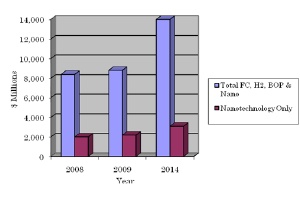Jun 23 2009
The lure of fuel cells is the promise to be one of the most ubiquitous products of the 21st century. Fuel cells can compete with batteries, the internal combustion engine and the power grid. Hydrogen can compete with any fuel now produced and cause no pollution but its price is higher than gasoline or natural gas because it is difficult to transport and store. Nanotechnologies will provide the technological keys that enable fuel cells and hydrogen as a fuel to become competitive and commonplace.

According to a newly released report from iRAP, Fuel Cells, Hydrogen Energy and Related Nanotechnology—A Global Industry and Market Analysis, the fuel cell and hydrogen energy industry is highly fragmented. Worldwide about 3870 organizations are involved in fuel cells, hydrogen energy and related nanotechnology and spent an estimated $8.4 billion in 2008. This market is estimated at $8.8 billion in 2009 and expected to increase to $14 billion by 2014, with a compound average growth rate of 9.6%. More than 2180 organizations are involved in nanotechnology related to fuel cells and hydrogen energy and will spend a total of $4.7 billion for fuel cells and hydrogen energy incorporating nanotechnology. Of that $4.7 billion, about $2 billion in 2008 represents the value of nanotechnology for fuel cells and hydrogen energy separate from all other expenditures.
Global Value for Fuel Cell, Hydrogen Energy and Related Nanotechnology, Through 2014 ($ Millions) (Source: iRAP, Inc.)
|
Organizations
|
2008
|
2009
|
2014
|
2009-2014 CAGR (%)
|
|
Total FC, H2, BOP & Nano
|
8,380
|
8,800
|
14,000
|
9.6%
|
|
Nanotechnology Only
|
2,010
|
2,190
|
3,090
|
7.1%
|
The organizations are made up of well established corporations, start-up companies, universities, governments at the federal, state and municipal level, cooperative public/private demonstrations, as well as non-profit organizations and laboratories. Those organizations involved in nanotechnology are developing electrodes, catalysts, membranes as well as nano coating, thermal and filtration products for fuel cells as well as materials for hydrogen production, purification and storage.
More than half the organizations involved in fuel cells, hydrogen energy and related nanotechnology have overlapping interests and are developing more than one kind of fuel cell or technology for more than one type of fuel cell. They may also offer balance of plant products that can be applied to more than one type of fuel cell such as fuel reformers, pumps and compressors and power electronics. Manufacturing equipment is also similar for some fuel cell types such as solid oxide fuel cells (SOFCs) and proton exchange membrane fuel cells (PEMFCs) even though their chemistry is very different. Nanotechnology manufacturing methods that can be applied to PEMFCs is often applicable to DMFCs as both use proton exchange membranes but different types of fuel.
Nanotechnologies offer a potential avenue for safe, solid storage of hydrogen for vehicles as well as methods of producing and purifying hydrogen from hydrocarbon fuels for use in fuel cells or via electrolysis of water or ammonia. Fuel cells require very pure hydrogen (99.95% or better) with many manufacturers striving to achieve 99.9999% pure or “six nines” for PEMFC which are very susceptible to poisoning by impurities which can lead to cell failure.
Although fuel cells represent less than ½ of one percent of the applications markets for power of any type, including portable power (where they compete against batteries and portable generators), stationary power (where they compete against the electric power grid), or vehicle power (where they compete against the internal combustion engine), it is growing at a faster speed. True mass manufacturing of stationary fuel cells will see its beginning in 2009 as manufacturers of a variety of fuel cells increase manufacturing capacity to 10,000s of units as their fuel cell products have proven to have the durability to compete against other sources of power. Prices have yet to significantly decrease but are expected to fall as mass production ramps up. Fuel cell manufacturers receive government support through subsidies as well as coordinated research and development. Limited mass production of fuel cell vehicles is not expected to begin before 2015, although many manufacturers will produce about 100 fuel cell vehicles a year for fleet demonstrations. Hydrogen fueling stations for these vehicles continues at a rate of about two to four a month worldwide. More than $500 billion worth of hydrogen fueling stations will eventually be needed to compete with the world-wide gasoline infrastructure.